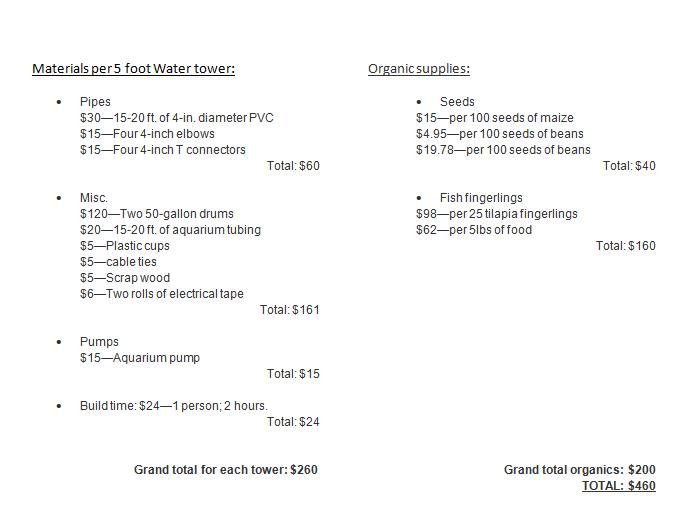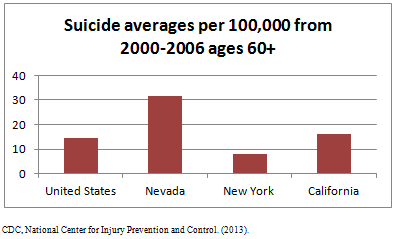Combating Suicide in the Nevadan Youth Population with Aquaponics

[linebreak]
Background information: Suicide is the third leading cause of death for Nevada youth, between the ages of 10-24. In fact, according to the Population Division, U.S. Census Bureau’s 2009 survey, it was found that 34,955 Nevadan youth attempted to commit suicide one or more times, annually. Overall, every sixteen minutes someone in the United States attempts suicide, and a large number of those attempts take place in Nevada [1]. There are more casualties related to suicide than the number of Nevadans who are inflicted with HIV/AIDS, or are victims of homicide and automobile accidents. On top of those discouraging statistics, Figure 1 details the fact that Nevada’s average suicide rate is more than double than the Country’s average.
To take a step back from the emotional aspect of this, the financial cost of suicides and suicide attempts is immense. The United States as a whole could save an average of one million dollars in medical expenses and lost productivity for each suicide [2]. Thus costs are heavy on economy stimulating corporations of 100,000 or more employees. In fact, PhD. Paul Quinnett calculates that corporations of this size 1.) lose one employee or family member of said employee every seven days, decreasing productivity; and 2.) deal with an average of three suicide attempts every day in that there are about approximately 25 nonfatal suicide attempts for every reported suicide.
Depression has been determined to be closely tied to suicidal tendencies, and several methods have been employed to deal with depression in children. The Office of Suicide Prevention has teamed up with the crisis Call Center to provide twenty-four hour support to anyone who calls their Suicide Prevention Hotline. However, many do not call, as is clear with the high rate of suicide. Suicide Prevention Awareness training has also been offered to over 900 Nevadans. Furthermore, using the Garrett Lee Smith (GLS) Memorial Act federal grant award, the Office of Suicide Prevention has partnered with Nevada PEP to provide youth mental health screenings in schools and primary health care settings. And while Screenings have proven somewhat effective at identifying many youths at risk of suicide, and protocol ensures referral to, and follow up with appropriate mental health service, many are still misdiagnosed to have ADD or go completely undiagnosed. Moreover, this method of therapy is expensive, often unaffordable, and more often than not, not fully covered by insurance. Children affected by depression have little to no idea of the Suicide Prevention Hotline, have likely had little to no contact with the small ratio of trained Nevadans, and have little energy, let alone the experience, to seek help.
Those who are identified as children affected by depression are typically sent to therapy or placed on expensive medication. The preferred treatment for severe depression is both medication and psychotherapy [3], as psychotherapy alone is unlikely to prevent suicidal individuals from attempting to kill themselves. In addition, the FDA warns that antidepressants may pose risks that are not worth the benefits when prescribed for children or adolescents affected by depression, with adverse side effects of aggression, further withdrawal, or even an increased risk of suicide.
While recognition of childhood depression is growing, the majority of the attention is on teenagers fifteen years and older. This is reasonable as the risk of suicide is higher in this age group, however children still suffer from neglect in the lack of effective treatment. The entirety of the symptoms, ultimately including suicidal efforts, does occur in these groups as previously mentioned. While the prevalence isn’t as great in children as it is in teenagers, it is reasonable to assume that many teens suffering from depression also suffered undiagnosed episodes of depression at an earlier age—at an age when treatment may have been more effective, as it is the time coping skills are best learned. So, while the Crisis Call Center’s Suicide Prevention Hotline continues to increase in call volume with 28,051 calls in 2009 to 29,370 calls in 2010, perhaps signifying victims slipping through the cracks, there remains an opportunity . For as figure 2 demonstrates, the number of Nevadan youth that turn to suicide is tragically inflated.

Solution: To combat this growing issue of suicide and its underlying contributor depression in Nevadan youth, I offer a solution that will nip the problem in the bud: the use of aquaponic greenhouses on elementary school grounds.
Starting in fifth grade and continuing to sixth, students will be given access to a greenhouse on their school’s campus in which to grow plants from seeds and raise fish. This would ultimately provide children with an opportunity of increased access to sunlight in an age with an ever stronger reliance on indoor computers, and with a chance to grow something that relies on them, as this will help the individuals feel more important utilizing increased responsibility, including those who go undiagnosed as affected with adolescent depression. In addition, the calm, group environment will better allow them to attain the ability to manage their stress and emotions.
The reasons: Sunlight has been shown to balance moods and keep sleeping patterns stable as has been proven with those suffering from seasonal affective disorder. While children spend more and more time indoors, with video games, TV and computers, sunlight exposure naturally decreases. In this vein, the lack of exercise they practice with be supplemented, too, which in itself is highly effective and recommended way of preventing depression (Carnacho, 222). Diet is a third basic issue that will be address as studies have shown that growing one’s own food helps with depression and will encourage healthier eating habits. In fact, one study found that thirty minutes of gardening decreasing cortisol (stress hormone) levels more than staying indoors and reading (Van Den Berg, A.E, 11).
Children will be given the chance to grow their own maize, beans, and squash. The idea of this also lends itself also history class learning, and offers hands on learning at that. The agricultural methods of The Three Sisters or the companion cropping of these three aforementioned vegetables will be utilized, in which the maze stalks serve as the climbing frame for the beans, the beans add nitrogen to the soil, and the squash block sunlight to avoid unwanted weeds (Phil Dudman). To be a lucrative venture, local demand of produce such as lettuce could be grown as well, by the younger age groups of the first through fourth grade. In fact, an aquaponic owner, Rob Goodier had stated that, “One five-foot tower can produce more than 200 heads of lettuce per year. And it uses a small fraction of the water needed to grow crops in soil.” This can be sold for approximately $0.50 a head. Meager, perhaps, but the real values come in with that saved with the prevented suicides.
This companion gardening in conjunction with fish tanks, in which the plants and fish form a symbiotic ecosystem, will minimize water need, eliminate soil completely, and the only real cost after initial construction with be fish food. But growing tilapia can pay for this if as an agreement with restaurants and retailers in the local market can purchase the fish and the vegetables. The time needed is a brief thirty minutes a day and the program can be utilized by both the science and history departments varying classrooms responsible throughout the year, leaving lasting knowledge on ways to cope with stress and emotions.
The blanket approach of this method eliminates the issue associated with misdiagnoses and those that elude identification, as all children are involved, not just those children affected by depression. It also gives more chances for socialization in a calm environment, and can ultimately fund itself after the initial construction of the greenhouse.
Costs: The cost for the initial construction of the greenhouse is approximately $25,000, including labor. With the construction of solar panels, crop output would increase, electricity cost would disappear, and energy could be sold back to the city. In addition with a 30% federal tax incentive, as well as state and local incentives, the cost for the panels drops significantly.
The consumption per kWh of power in Reno, NV is $0.15 taken from of average of summer peak, summer off-peak, and the pricing for October through May. No more than 4,500 kWh are expected to be consumed annually, as the average household consumes, 8,900 and are much larger in square footage and furthermore, more diverse and plentiful in their electrical appliances. Thus only $56.25 would be expected monthly to pay for the energy consumption of the greenhouse to run the aquarium pumps and the strip lighting which the profit of selling fish and crops to local markets would more than cover. Thus this cost can be eliminated all together, and at the same time protect crops from over exposure to the sun. The sun provides 1,000 W/m² while plants only require 250 to 350 W/m². This excess inhibits plant growth rather than lending itself to it. The solution to this problem is the Chinese lean-to greenhouse with partitioned solar panels. Figure 1 illustrates the set up of the Chinese lean-to style greenhouse.
Staffing costs are not a concern as while the children learn and benefit from the greenhouse, they are tending to it. Teacher will provide supervision just as any P.E. teacher would. As mentioned the program has ties to both science and history classes, and can also be utilized to demonstrate healthy eating habits in health classes, and serve as subject matter for writing projects for English classes.
[linebreak]
Cost of cabbage towers and larger system organics: Addition towers could be constructed to grow heads of cabbage rapidly to keep up with the demand of local markets and create more monetary flow. The breakdown cost of these system’s initial construction follows along with the starting seed costs and fingerlings prices. Ultimately the Tilapia will breed new generations and the crops will produce more seeds.
Conclusion: With the construction of an aquaponics greenhouse on elementary school grounds, a strong foundation will be laid for every child that participates. The project will eventually pay for itself and these funds could go to create additional greenhouses at surrounding schools, or into other non-profit programs. No participating child will fall through the cracks as too often happens with mental health screenings, as all will be given equal access granting a sense of equality, a calm environment, and a sense of responsibility.
Children will be cutting crops rather than their lives short.
[1]Centers for Disease Control and Prevention [2] Research America, www.researchamerica.org/uploads/factsheet21suicide.pdf [3] Cytryn &McKnew, 143